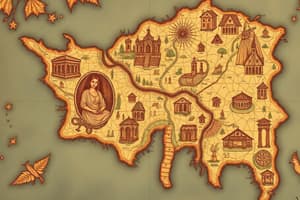Podcast
Questions and Answers
Which of the following transformations maintains all shapes and has a uniform point scale factor in all directions?
Which of the following transformations maintains all shapes and has a uniform point scale factor in all directions?
- Conformal Transformation (correct)
- Affine Transformation
- Projective Transformation
- Datum Transformation
Projective transformations convert 2-dimensional shapes to 3-dimensional shapes and vice versa.
Projective transformations convert 2-dimensional shapes to 3-dimensional shapes and vice versa.
False (B)
What is another name for Conformal Coordinate Transformations?
What is another name for Conformal Coordinate Transformations?
Similarity Transformation
An Affine Coordinate Transformation has a scale factor that ______ in different directions.
An Affine Coordinate Transformation has a scale factor that ______ in different directions.
In a 2-D Helmert transformation, what is the minimum number of control points required to uniquely determine the transformation parameters?
In a 2-D Helmert transformation, what is the minimum number of control points required to uniquely determine the transformation parameters?
In 2-D coordinate transformations, the true shape of an object is altered after a conformal transformation.
In 2-D coordinate transformations, the true shape of an object is altered after a conformal transformation.
What are the three steps involved in a two-dimensional conformal coordinate transformation?
What are the three steps involved in a two-dimensional conformal coordinate transformation?
In the context of coordinate transformations, control points are common to ______ systems.
In the context of coordinate transformations, control points are common to ______ systems.
Match the parameters with their descriptions in the context of 2-D Helmert transformation:
Match the parameters with their descriptions in the context of 2-D Helmert transformation:
In the equation $X = (S \cos \theta)x - (S \sin \theta)y + T_x$, what does the variable $T_x$ represent?
In the equation $X = (S \cos \theta)x - (S \sin \theta)y + T_x$, what does the variable $T_x$ represent?
The equation $ax - by + c = X + v_x$ represents an observation equation in least squares adjustment.
The equation $ax - by + c = X + v_x$ represents an observation equation in least squares adjustment.
In matrix form, AX = L + V, what do A, X, L and V represent respectively?
In matrix form, AX = L + V, what do A, X, L and V represent respectively?
In 3-D Conformal Transformation, the rotation matrix is composed of three consecutive 2-D rotations about the x, y, and ______ axes.
In 3-D Conformal Transformation, the rotation matrix is composed of three consecutive 2-D rotations about the x, y, and ______ axes.
How many parameters are involved in a 3-D conformal transformation?
How many parameters are involved in a 3-D conformal transformation?
According to the material, a 3-D Coordinate Transformation is also known as the four-parameter similarity transformation.
According to the material, a 3-D Coordinate Transformation is also known as the four-parameter similarity transformation.
In 3-D coordinate transformations, list any two of the seven parameters the transformation involves.
In 3-D coordinate transformations, list any two of the seven parameters the transformation involves.
After the adjustment, scale factor S and rotation angle θ are computed using θ = tan-1(b/a) and S = a/cos θ, a and b relate to parameters in the ______ equation.
After the adjustment, scale factor S and rotation angle θ are computed using θ = tan-1(b/a) and S = a/cos θ, a and b relate to parameters in the ______ equation.
Match the coordinate transformation type with its representative real-world applications:
Match the coordinate transformation type with its representative real-world applications:
What parameters are obtained as transformation results in the given example calculation?
What parameters are obtained as transformation results in the given example calculation?
For unique solution in 3-D conformal transformation, seven equations must be written requiring a minimum of 3 control stations with known XY coordinates and also xy coordinates, plus 2 stations with known Z and z coordinates.
For unique solution in 3-D conformal transformation, seven equations must be written requiring a minimum of 3 control stations with known XY coordinates and also xy coordinates, plus 2 stations with known Z and z coordinates.
Flashcards
Coordinate Transformation
Coordinate Transformation
Transformation of points from one coordinate system to another.
Projective Transformations
Projective Transformations
Transforms 3D shapes to a 2D flat surface, like geographic coordinates to a Mercator projection.
Affine Coordinate Transformations
Affine Coordinate Transformations
Scale factor differs in different directions, like rubber sheeting.
Conformal Coordinate Transformations
Conformal Coordinate Transformations
Signup and view all the flashcards
Module Coverage
Module Coverage
Signup and view all the flashcards
ITRF Transformations
ITRF Transformations
Signup and view all the flashcards
Datum Transformation
Datum Transformation
Signup and view all the flashcards
2-D Coordinate Transformation (Helmert)
2-D Coordinate Transformation (Helmert)
Signup and view all the flashcards
Scaling (2-D Transformation)
Scaling (2-D Transformation)
Signup and view all the flashcards
Rotation (2-D Transformation)
Rotation (2-D Transformation)
Signup and view all the flashcards
Translations (2-D Transformation)
Translations (2-D Transformation)
Signup and view all the flashcards
Control Points
Control Points
Signup and view all the flashcards
Scaling Equation
Scaling Equation
Signup and view all the flashcards
3-D Conformal Transformation
3-D Conformal Transformation
Signup and view all the flashcards
Parameters of 3-D Transformation
Parameters of 3-D Transformation
Signup and view all the flashcards
Control Station Requirement
Control Station Requirement
Signup and view all the flashcards
Study Notes
Geodetic Coordinate Systems
- Focuses on conformal two and three dimensional coordinate transformations
Introduction
- Transforming points between coordinate systems is common in Geodesy, Geoinformatics, and GIS.
- Projective Transformations convert 3D shapes to 2D surfaces and vice versa, like geographic coordinates to Transverse Mercator.
- Affine Coordinate Transformations involve scale factor variations in different directions, like rubber sheeting and georeferencing.
- Conformal Coordinate Transformations preserve shapes, maintaining a uniform point scale factor, also known as similarity transformation, for example, datum transformation.
Scope
- Covers introductory procedures using least squares
- Focuses on conformal 2D and 3D transformations.
- Includes applications in GIS, such as ITRF and datum transformations.
2-D Coordinate Transformation (Helmert)
- Also known as four-parameter similarity transformation, maintaining the true shape after transformation
- This can be broken down into three steps: scaling, rotation, and translation.
- Scaling uses 1 parameter to equalize dimensions across coordinate systems.
- Rotation uses 1 parameter to align the reference axes of coordinate systems.
- Translations uses 2 parameters (∆X, ∆Y) to establish a common origin.
- Requires at least two control points shared between systems.
- Uniquely determines the four transformation parameters with a minimum of two points
- Least squares adjustment becomes possible when more than two control points are available.
- Any point in the original system can be transformed into the second system once transformation parameters are known.
Equation Development
- Points A, B, and C have coordinates known in both systems, while points 1-4 are only known in the xy system.
- Scaling: x' = Sx and y' = Sy (eq 1), maintains lengths between points in the xy system when converting to XY.
- Rotation: X' = x' cos 𝜃 – y' sin 𝜃 and Y' = x' sin 𝜃 + y' cos 𝜃 (eq 2).
- Translation: X = X' + TX and Y = Y' + TY (eq 3), is used to align origins, completing the coordinate transformation to XY.
- Combining the scaling, rotation, and translation: X = (S cos 𝜃)x – (S sin 𝜃)y + TX and Y = (S sin 𝜃)x + (S cos 𝜃)y + TY.
- Adding residuals and using S cos 𝜃 = a, S sin 𝜃 = b, TX = c, and TY = d gives: ax − by + c = X + vX and bx + ay + d = Y + vY (eq 4).
Application of Least Squares
- Equation 4 is the 2D conformal coordinate transformation equation, which has 4 unknowns: a, b, c, and d
- These unknowns represent the transformation parameters S (scale), 𝜃 (rotation), TX and TY (translation)
- Two observation equations are needed for each control point; thus, for three control points (A, B, and C), six equations can be written:
- axa − bya + c = XA + vXA, bxa + aya + d = YA + vYA
- axb − byb + c = XB + vXB, bxb + ayb + d = YB + vYB
- axc − byc + c = XC + vXC, bxc + ayc + d = YC + vYC
- Expressing these in matrix form: AX = L + V, where A contains coefficients of the unknowns, X is the vector of unknowns, L is the vector of observations, and V is the vector of residuals.
-
Scale factor (S) and rotation angle (𝜃) can be determined after adjustment:
- 𝜃= tan-1 of (b/a)
- S= a / cos 𝜃
Example of 2-D Helmert Transformation
- Coordinates provided for points A, B, and C in both E/N and x/y systems, along with x/y coordinates for points 1 and 2
- The observation equation is formed for each point:
- axa – bya + c = EA +vEA
- bxa + aya + d = NA + vNA
- axb – byb + c = EB + vEB
- bxb + ayb + d = NB + vNB
- axc – byc + c = EC + vEC
- bxc + ayc + d = NC + vNC
- Expressed in Matrix form as: AX = L + V, this is solved to find the transformation parameters.
- Using the solution:
- E = (S cos 𝜃)x – (S sin 𝜃)y + TX
- N = (S sin 𝜃)x + (S cos 𝜃)y + TY
- Coordinates for points 1 and 2 are transformed from x/y to E/N.
3-D Conformal Transformation
- Involves seven parameters: three rotations, three translations, and one scale factor
- Also know as a seven parameter similarity transformation
- Transfers points from one 3D coordinate system to another.
- Rotation matrix is obtained from 2D rotations about x, y, and z.
- Rotation 𝜃1 about the x-axis in matrix form:
- X1= RX0, where X1 is the rotated coordinate, R1 is the rotation matrix, and X0 is the original coordinate, note eq a as well with the component matrices
- Rotation 𝜃2 about the y-axis in matrix form:
- X2 = R2X1, with eq b.
- Rotation 𝜃3 about the z-axis in matrix form:
- X = R3X2, with eq c
- Substituting a into b and into c gives:
- X = R3R2r1X0 = RX0
- Three matrices produce single rotation matrix R for the transformation.
- Components = r11, r12, r13, r21, r22, r23, r31, r32, r33
3-D Transformation Mathematical Model
- Rotation matrix R is orthogonal so its inverse is equal to its transpose.
- Terms of matrix X multiplied by scale factor, S, and adding translation factors TX, TY and TZ. Translating to a common origin yields the mathematical model.
- X = S(r11x + r21y + r31z) + TX,
- Y = S(r12x + r22y + r32z) + TY,
- Z = (r13x + r23y+ r33z) + TZ
- The equation above have 7 unknowns which include: S, 𝜃1, 𝜃2, 𝜃3, TX, TY, TZ
- Unique solutions need 7 equations so a minimum of 2 control stations along with known XY coordinates with plus 3 stations that XY coordinates known is needed.
- If there are more control points than needed, a least squares solution may be applied.
- The mathematical model calculation must be linearized to be solvable.
Studying That Suits You
Use AI to generate personalized quizzes and flashcards to suit your learning preferences.




